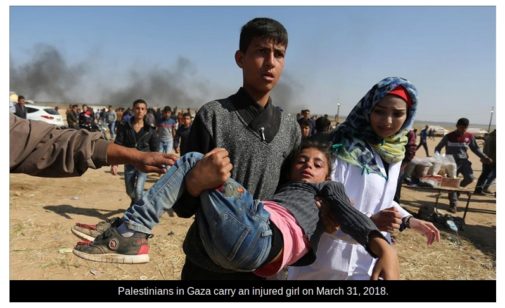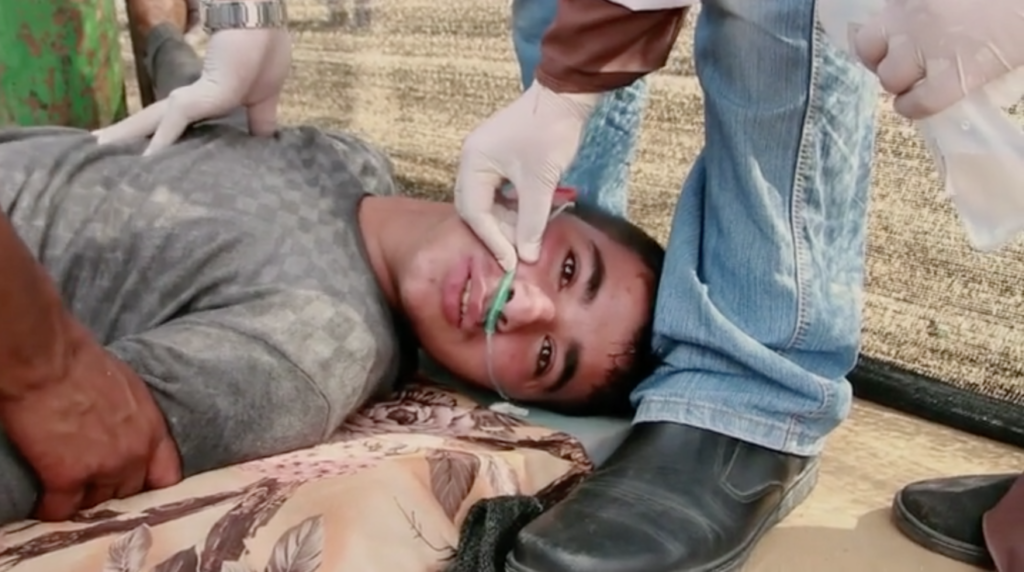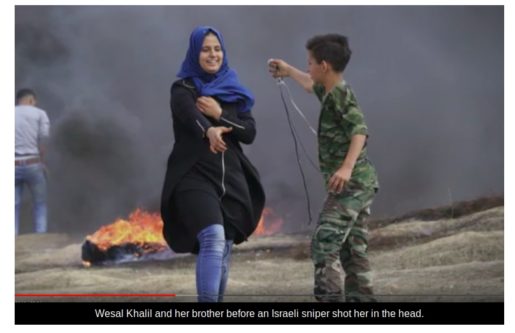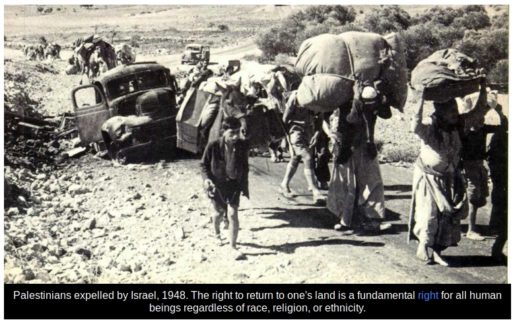PBS stations around the U.S. were scheduled to show a riveting new Frontline documentary, “One Day in Gaza,” but at the last minute PBS pulled it.
The film is missing important context about the issue, but it includes footage that Americans, as Israel’s top funders, should see – including a young, unarmed teen being shot in her head.
BBC, the coproducer of the film, broadcast it to British viewers. We are posting it below so that Americans can also view it.
Recently, hundreds of PBS stations around the United States were scheduled to broadcast a powerful new Frontline documentary: “One Day in Gaza.” But viewers tuning in found that it had been replaced by a slightly updated Frontline report on Robert Mueller that had been broadcast two months before and had been streaming online ever since.
PBS no longer has the Gaza film listed on its schedule.
The documentary was to be aired on the one-year anniversary of events that took place on May 14, 2018, when tens of thousands of men, women, and children in Gaza gathered with the intention of deploying the tactics Gandhi had used in freeing India from British control.
The demonstration that day was the 8th march in what Gazans named the Great March of Return.
Palestinians months earlier had announced their plan for a mass, peaceful demonstration in which Gazans would march for an end to Israel’s crippling 12-year blockade and, especially, for their right to return to homes stolen by Israel in order to create a Jewish state. Palestinians’ right to return to their homes and ancestral land is well established in international law. This fundamental right, affirmed in the Universal Declaration of Human Rights, is at the center of the Israeli-Palestinian conflict.
Israel had responded by immediately deploying a hundred snipers.
In the first seven weekly marches, Israeli forces killed about 50 of the marchers and injured over 7,000.
During the 8th march on May 14, the day depicted in the film, Israeli forces killed 60 more and shot 1,000 – an average of one person every 30 seconds.
While this was going on, a glittering Israeli celebration was taking place as a new, transplanted U.S. Embassy opened in Jerusalem, a city that Israel illegally annexed following the Six-Day War that Israel launched in 1967.
Who were the protesters?
Over 70 percent of Gazans are from families that Israel forced out in its founding war to establish “the Jewish state.” Israel confiscated their homes and land and has prevented them from returning ever since. This violates international law.
For 12 years Israel has perpetrated a strangling blockade of Gaza, causing 52 percent unemployment, hunger, the kind of malnutrition that causes growth stunting in children, and increasing hopelessness.
And this blockade is just the most recent one.
On April 15, 2002 the UN Food and Agriculture Organization reported, “The total blockade has paralysed the Palestinian economy… it is now in a deep recession, with millions of people severely impoverished and extremely food insecure.”
For many years it has been tremendously difficult, sometimes impossible, for Gazans to leave Gaza, and for others to enter it. As a result, many people describe Gaza as the largest open-air prison on earth.
While U.S. news coverage in general, and the Frontline documentary in particular, emphasize the rockets fired by Gaza’s diverse resistance groups, the fact is that Israeli violence preceded the rockets and has greatly exceeded their impact.
In the past year alone, Israeli forces have killed at least 293 Gazans, while Gazans have killed 6 Israelis. Palestinian rockets from Gaza, which are largely homemade, have killed a total of about 40 Israelis in the whole time they’ve been being shot, while during the same time period Israeli forces have killed over 6,000 Gazans. (See this Timeline of deaths and this Israeli source for more info.)
The film says that Israel “fought three major conflicts with Hamas,” but doesn’t mention that during these, Israeli forces killed about 3,600 Gazans (many of them women and children), while Gazan fighters killed approximately 80 Israelis, the large majority of them soldiers.
Powerful but flawed
The Frontline documentary One Day in Gaza is an extremely powerful, if flawed, record of the events of May 14, 2018.
It provides Israeli views, Palestinian views, and riveting, often tragic footage of the day’s events. However, perhaps because of its striving to be “balanced,” or due to constraints imposed by Israel’s powerful lobbies in England and the U.S., the film often leans toward the Israeli narrative and obscures some important points.
The Israeli interviewees in the film are calm, articulate, and seem well-trained in presenting their talking points. Perhaps this is not surprising given that one is an army spokesman, a second is a high-ranking officer, and two are Americans who immigrated to Israel (although this fact is not revealed in the film).
Not interviewed in the film are any of the members of the Israeli group, Breaking the Silence, composed of former Israeli soldiers who describe widespread military practices of gratuitous violence and cruelty.
Below is some background on two of the Israelis featured in the film:
Col. Kobi Heller
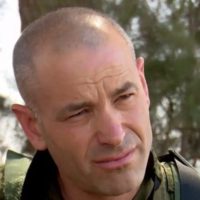 Perhaps because of time constraints, Col. Heller’s, background and political persuasion are left out of the film.
Perhaps because of time constraints, Col. Heller’s, background and political persuasion are left out of the film.
While Heller comes across as reasonable, professional, and reluctant to commit the murders we see from his troops, his resumé suggests that there is more to his story.
Heller is a member of Israel’s Religious Zionist movement, a group that has become known for its zealotry and sometimes extremist views of Jewish supremacy. He is called a “kippa shruga,” a term for the type of Jewish fundamentalist known for believing that Arabs should be expelled from Israel and for opposition to any Palestinian state, no matter how small.
It turns out that he has a previous connection to Gaza. Heller is a settler who studied at a religious Zionist yeshiva in a Gaza settlement that combined religious studies with military training. In 2005 the yeshiva was moved to Israel when the Israeli government forcibly expelled the settlers. This caused fierce objections in the settler movement. Many in the army were outraged at this action.
Heller is from Israel’s notorious Golani brigade, increasingly a bastion of the Israeli far right. An Israeli professor states: “The officer corps of the elite Golani Brigade is now heavily populated by religious right-wing graduates of the preparatory academies.” The New York Times reports that many Israelis are concerned at this development, particularly since a booklet was handed out to soldiers during Israel’s 2009 assault on Gaza that contained a rabbinical edict against showing the enemy mercy.
The Times reports: “The rabbinate brought in a lot of booklets and articles and their message was very clear: We are the Jewish people, we came to this land by a miracle, God brought us back to this land and now we need to fight to expel the non-Jews who are interfering with our conquest of this holy land.”
Adele Raemer
 An Israeli woman featured in the film is Adele Raemer. She is described as an “Israeli grandmother” who lives two kilometers from the Gaza fence.
An Israeli woman featured in the film is Adele Raemer. She is described as an “Israeli grandmother” who lives two kilometers from the Gaza fence.
In the film she describes her fear of Gazans who wish to return to their homes in Israel. The film does not mention that Raemer is originally an American from the Bronx.
In 1975 she immigrated to Israel and took up residency in the Nirim kibbutz on the border with Gaza. Since the area had originally possessed no history of Jewish habitation, the Zionist movement had established it in 1946 to create a Jewish presence in the Negev in order to claim it as part of a future Jewish state.
Raemer has written that her life in the kibbutz is “95 percent heaven.” Despite being located in a desert, it has green grass and a swimming pool. A little over a mile away, Gazans are enduring a water crisis that has caused Gazan children to suffer from diarrhea, kidney disease, and impaired IQ.
Hamas and Islamic Jihad leaders
The film shows the the flaws and sometimes fatal logistical failures of Hamas and Islamic Jihad leaders during the Great March and says that Hamas has “refused to recognize Israel.”
However, the film doesn’t include the fact that Hamas has offered Israel a decade-long truce, that it is Israel that breaks the truces, and that Hamas has said it was willing to accept a Palestinian state within the 1967 borders.
In reporting these leaders’ flaws and mistakes, the film fails to mention the extreme difficulties Gaza’s leaders face, including the fact that by assuming this role they face very possible assassination by Israel. Many resistance members have been blown to pieces by Israeli drones.
Those who survive are trying to run a resistance movement, deploy efficient logistical support, and make wise decisions during chaotic conditions in one of the world’s most isolated and longest-besieged enclaves.
Most important, the Palestinian journalist and peace activist who originated the march and is interviewed in the film, Ahmed Abu Artema, says that the film attributed far too much significance to Hamas, and neglected the “primary role played by civil society activists in Gaza.”
In a detailed critique of the film, he writes: “The documentary did not show the reality of the prison that Gaza has become. One shot of the cattle market that exists at the Erez crossing would have been enough to convey the reality of this cage, where there is no freedom of movement, no economic growth, no future prospects – no hope.”
The U.S. connection
The film also fails to inform American viewers of our connection to Israeli actions – that the U.S. gives Israel over $10 million per day. (The U.S. has given Israel on average 7,000 times more per capita than it has given other people around the world.)
And in its framing, the film neglects the fact that a prime driver of Trump’s decision to move the U.S. embassy is billionaire campaign donor Sheldon Adelson, who attended the celebration with his Israeli wife Miriam. (Adelson once said that he regretted serving in the U.S. army rather than the Israeli one – video here.)
Despite its flaws, Americans should see it
But the film cannot do everything, and it does some things extremely well. Overall, it’s not difficult to see why Israel partisans would not wish it broadcast to Americans.
It shows footage that the American public almost never sees. It was this kind of footage that eventually led to Americans ending the Vietnam war.
One of the main take-aways from the film is the extreme ruthlessness of Israeli forces.
Fully armed Israeli soldiers from one of the most powerful armies on earth are seen targeting multitudes of thin, unarmed men, women, and children. The film shows Israeli snipers shooting people in the head, in the back, in the legs.
It shows a youth whose leg was amputated and reports that many of the demonstrators lost limbs that day. (The UN recently reported that 1,700 Gazans shot by Israeli snipers are currently at risk of amputations.)
While U.S. news reports often downplay these actions, the film shows them in all their tragic and horrific reality.
The film shows people who are just standing there suddenly being picked off by snipers. It shows a 14-year-old girl chatting with a friend, then suddenly being shot in the head. And it shows her little brother, who had been with her, later describing how his sister had been killed. This is not footage that Israeli hawks wish American audiences to view.
Another takeaway from the film is the poverty of Gaza’s imprisoned population, particularly compared to the gathering in Israel to celebrate the U.S. Embassy move to Jerusalem.
Amid the expensive suits and fashionable dresses, American-born Israeli official Michael Oren bemoans the fact that the situation in Gaza has blemished his enjoyment of the festive occasion.
This contrast with Gaza is stark.
With no powerful lobby to represent them and little clout in U.S. media, Palestinians are at the mercy of Israel. The film shows that many in Gaza feel they have little to lose after years of escalating oppression. Some voice impossible dreams that had motivated them, that they could recover their lost homes. Some simply hoped to see them. A few voice the fury that results from dispossession, imprisonment, and brutalization.
While this goes unremarked in the film, there are indications that the “tear gas” Israeli drones poured on people may have been particularly virulent. In the film we see some people convulsing, and one man is delirious. This seems reminiscent of a mysterious gas used in Gaza in early 2001 that caused similar symptoms (reported in the James Longley documentary Gaza Strip).
Courage
While Israeli soldiers shelter behind diverse barriers, armed with advanced weaponry and guided by female soldiers watching it all on TV screens in a remote bunker, it is the Palestinians who demonstrate incredible, sometimes tragic courage.
We see them without weapons, without body armor, without helmets, without uniforms. Old and young, men and women, strong and disabled, they wield slingshots, wave flags.
They’re out in an open field, Israeli forces in front of them, drones overhead. When yet another demonstrator is shot, the blood pouring out, they run to rescue him or her, and then sometimes they, too, are shot. Yet they continue.
The contrast between the Israeli and Palestinian women taking part in the day’s hostilities is acute. Israeli female soldiers are far away, watching the action on computer monitors, telling soldiers when and where to shoot. Their faces are blurred to keep their identities secret. One seems to question what she’s doing, but there’s no indication that she stops.
Gazan women join the mass gathering. They’re out are in the open field, marching, carrying flags, helping the injured… and getting shot.
Theft of a nation
For over 70 years, Israel has gotten away with its astoundingly massive theft of the land and homes of the non-Jews it dispossessed to create an ethnically defined nation, and its decades of violence to maintain this ethnic cleansing. A Palestinian historian has validly termed this the Palestinian Holocaust.
One Day in Gaza shows some of Israel’s millions of victims, their attempt to be free, and what’s being done to them. Americans are not supposed to see that.
While Artema’s biting critique of the film is valid and necessary, it is useful to be aware that for many Americans much of the film will be revelatory.
PBS’s action
PBS’s cancellation, however, has prevented Frontline‘s more than 4.6 million viewers from seeing it.
While PBS calls itself “a trusted window to the world,” someone at PBS shuttered the window on One Day in Gaza.
PBS spokespeople state that Gaza will be broadcast at some point in the coming months, but say they don’t know when. Since the film’s scheduled broadcast date was specifically focused on the one-year anniversary of the day it depicts, it seems odd for PBS to be so unconcerned about broadcasting it in a timely manner. BBC, on the other hand, aired the film on May 13.
According to a Frontline statement, One Day In Gaza was pulled because Frontline “decided to air a timely update to our documentary on the Mueller investigation.” The Mueller investigation report had been broadcast on March 16 and 17 and has been available online ever since. It can be viewed here.
The updated version that bumped One Day in Gaza can be seen here. The update consists of a few minutes added at the end of the report. This new information had already been reported widely in U.S. media, including PBS’s own primetime news program News Hour.
PBS vs local stations
PBS wields considerable power. A national study rated PBS “the most-trusted institution in America.”
Its Frontline program claims to be “American television’s top long-form news and current affairs series.”
According to its website, PBS is a “near-universal media service, available in 9-of-10 U.S. television households. For many Americans, public television is their connection to the world.”
PBS emphasizes the alleged independence of its nearly 350 television and radio stations, stating they are among “the last locally owned media organizations in the country.”
However, in reality it appears that local stations have less control than this implies. When someone at PBS prevented the broadcast of Gaza, that decision prevented all the local stations around the country from airing it.
The fact is that local PBS stations do not have independent access to the film – even though it received funding from the stations.
While most Americans may think that PBS is a public institution, given its name – Public Broadcasting Service” – it is not. It is, in its own words, “a private, nonprofit media enterprise.” One that is, however, largely funded by American taxpayers.
Its ownership is a bit convoluted and multi-layered. While it says it is “owned by its 350 member stations,” its funding comes from the Corporation for Public Broadcasting. CPB is another private nonprofit, but 95 percent of CPB’s funding comes from the federal government. Most of this money is then given to the member stations.
Phone calls to a PBS station, KQED in San Francisco, revealed that KQED had received many calls complaining about the cancellation and asking when Gaza would be shown. KQED’s customer service representative explained that none of this is in KQED’s hands.
“We Answer to You”
Frontline has refused to divulge who was involved in the decision to pull Gaza. It seems likely that its Senior Editorial Team – consisting of Raney Aronson-Rath, Executive Producer; David Fanning, Founder and Executive Producer at Large; and Andrew Metz, Managing Editor – would have been involved. Fanning has previously been accused of censoring content regarding Israel/Palestine, a charge he denies.
Frontline‘s website announces: “We answer to no one but you.”
It’s unclear who the “you” is. It does not appear to be the member stations who fund it, or the many people whose federal dollars financed the film and wish to see it.
While PBS holds on to the film and fails to release it, people in Gaza continue their David against Goliath struggle.
On May 15th, Gazan men, women, and children again protested, and Israel again unleashed its heavily armed military, injuring 144, including 49 children. The same day, Israeli soldiers also fired at fishermen who were fishing off the coast of Gaza, injuring one of them – a frequent occurrence that Americans rarely, if ever, see on the News Hour.
And so it goes.
Perhaps at some point PBS/Frontline management will decide that the massacre of 60 people and the shooting of a thousand others in a single day is important enough to merit scheduling the film – particularly when the perpetrator has received more U.S. tax money than any other nation in the world.
This post will be updated if PBS schedules a new broadcast date.
It will be updated again if PBS actually shows it.
WATCH: One Day in Gaza Download: Torrent | Magnet Link












